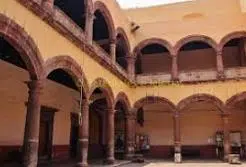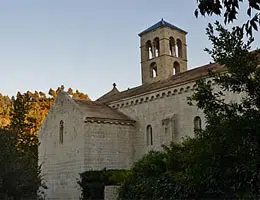 The etymological history of cloister begins in the Latin claudĕre , which can be translated as “close.” Claudĕre derived from claustrum , a notion that is linked to a monastery and that came to our language as a cloister.
The etymological history of cloister begins in the Latin claudĕre , which can be translated as “close.” Claudĕre derived from claustrum , a notion that is linked to a monastery and that came to our language as a cloister.
The gallery that surrounds the central patio of a convent , a monastery or a church is called a cloister. These cloisters have galleries known as pandas or pandos on each of their sides. In the pandos are the spaces used in cloistered life.
Square in plan, the cloister patio usually has a place in the center where four paths intersect. The pandos, for their part, have galleries covered with arcades . Through the cloister you have access to the chapter house, the heater and other rooms.
The concept of cloister is also used in the field of education . A faculty is the group of teachers who work in an establishment or the meeting that brings together these teachers. Faculty, on the other hand, is the board of directors of a university.
The so-called faculty usually meets at least once a quarter. Through this participatory body, teachers can plan, coordinate and analyze the various pedagogical activities carried out in the educational establishment.
A university faculty is a representative body of a university , made up of the various sectors that are part of it. Currently, it is common for the faculty to integrate teachers, students and non-teaching staff (administrative and service).
Catalan Romanesque cloisters
 In Spain, the largest number of cloisters is found in Catalonia, and some of them are considerably large. The oldest of all is in the Gerona Cathedral . It is important to note that the Catalan cloisters do not present many apparent differences, especially in their architecture, but rather it is their ornamentation that allows us to distinguish them from each other.
In Spain, the largest number of cloisters is found in Catalonia, and some of them are considerably large. The oldest of all is in the Gerona Cathedral . It is important to note that the Catalan cloisters do not present many apparent differences, especially in their architecture, but rather it is their ornamentation that allows us to distinguish them from each other.
Broadly speaking, we can see arcades that rest on reinforcement buttresses and paired columns . Robust pillars rise at its corners. The shafts have the same proportions in almost all the cloisters of Catalonia, and the same occurs with the height of the parapets; In fact, its structure is very similar to that of the buildings in the south of France and Italy, which is why it is estimated that the masons who built them were Lombards.
It is only when we observe the sculptures on the capitals that we can differentiate the Catalan cloisters. These are attributed to local specialists, some of whom left their own effigy, something that can be seen in the monasteries of San Benito de Bages and Sant Cugat del Vallés .
The number of monks in the monastery had a direct impact on the design of the domestic rooms of the cloister. In the particular case of the Benedictines, the cloister was located next to the south wall of the temple, with certain exceptions. The capitals had an ornamentation that could be historic or vegetal, with the possibility of including figures of animals or people.
The authors had complete freedom to decorate the capitals, and to do so they let their imagination fly, although they tended to repeat their formulas in the different monasteries in which they worked.
The different departments of the cloister were adapted to the needs of each moment, so that their importance varied throughout history. Generally, the layouts were in accordance with what was dictated by the Order of Cluny , a reform of the Benedictine order dating back to the 10th century. The galleries, for example, are intended for meditation, walking and meetings, while Community and daily life took place in the challenge of the dependencies.
